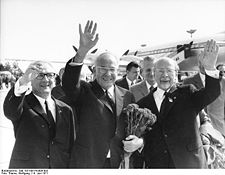
Husák's Children
Encyclopedia

Baby boom
A baby boom is any period marked by a greatly increased birth rate. This demographic phenomenon is usually ascribed within certain geographical bounds and when the number of annual births exceeds 2 per 100 women...
which started in the early 1970s, during the period of "normalization
Normalization (Czechoslovakia)
In the history of Czechoslovakia, normalization is a name commonly given to the period 1969 to about 1987. It was characterized by initial restoration of the conditions prevailing before the reform period led by Alexander Dubček , first of all, the firm rule of the Communist Party of...
". The generation was named after the President and a long-term Communist
Communist Party of Czechoslovakia
The Communist Party of Czechoslovakia, in Czech and in Slovak: Komunistická strana Československa was a Communist and Marxist-Leninist political party in Czechoslovakia that existed between 1921 and 1992....
leader of Czechoslovakia, Gustáv Husák
Gustáv Husák
Gustáv Husák was a Slovak politician, president of Czechoslovakia and a long-term Communist leader of Czechoslovakia and of the Communist Party of Czechoslovakia...
.
State pro-population policy in the 1970s
The most significant post-war baby boom in Czechoslovakia culminated in 1974. After the events of the Prague SpringPrague Spring
The Prague Spring was a period of political liberalization in Czechoslovakia during the era of its domination by the Soviet Union after World War II...
in 1968 and subsequent restoration of the conditions prevailing before the reform period, many Czechoslovaks resigned themselves to their fate and became unconcerned with the political situation in the country. In reaction, the Czechoslovak communist régime came with its own version of Goulash Communism
Goulash Communism
Goulash Communism or Kádárism refers to the variety of communism as practised in the Hungarian People's Republic from the 1960s until the collapse of Communism in Hungary in 1989...
, presented in a new concept: the state pro-population policy. The duration of maternity leave was extended, the child allowance increased, and newlyweds were subsidized with attractive state loans. However, the "generous" state policy soon reached its limits. In the late 1970s, the state finance reserves intended for the support of the pro-population policy were limited and the baby boom ended. The influence of the state pro-population policy has been questioned in the past. The population growth began to increase in 1969. The state financial subsidy was approved in 1973 and the baby boom culminated in 1974. After the initial sharp increase, the birth rate began to decline. The roots of the unusual population explosion could be associated with the post-war period rather than the "social engineering" of the communist regime.
21st century
As of the first decade of the 21st century, the generation of Husák's children represent an important element of Czech society. The 1970s generation of baby boomers caused another significant population increase in the late 2000s. Husák's children also became a target of a marketing and economic "retro-invasion" on the Czech market. After the fall of the Iron CurtainIron Curtain
The concept of the Iron Curtain symbolized the ideological fighting and physical boundary dividing Europe into two separate areas from the end of World War II in 1945 until the end of the Cold War in 1989...
, following a period of fascination with almost any Western product, Czech society gradually turned its attention back to the traditional Czech brands. The marketing campaigns of the companies began to focus on the productive generation and its nostalgia for its childhood. Retro designs of products and brands known in the 1970s and 80s appeared on the Czech market once again.
The term Husák's children appeared in the words of the song 1970 by the Czech band Chinaski:

